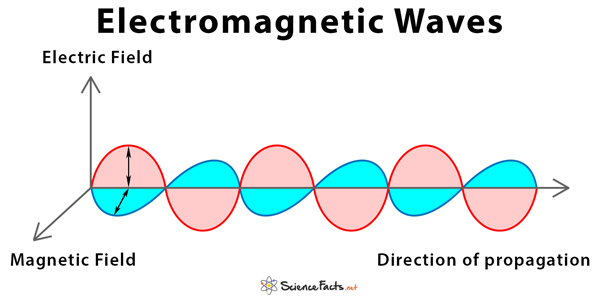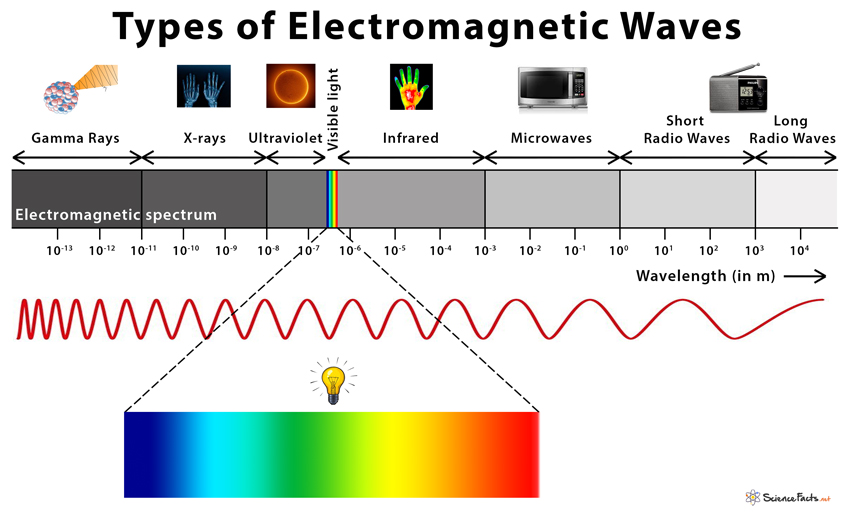Electromagnetic Waves
Definition: What are Electromagnetic Waves?
Electromagnetic (EM) waves, also called electromagnetic radiation, are created by the coupling of oscillating electric and magnetic fields, whose directions are perpendicular to each other. The direction of propagation of the EM wave is perpendicular to both the electric and magnetic field vectors. Unlike mechanical waves, electromagnetic waves do not need a medium to propagate. They can travel in a vacuum with the speed of light. The heat from a burning fire, the light from the sun, the X-rays used by a doctor, and the energy used for cooking food in a microwave are all examples of electromagnetic waves.
Characteristics of Electromagnetic Waves
- Motion is similar to transverse waves, except that it does not require any medium to travel
- Consist of electric field and magnetic field perpendicular to each other and the direction of propagation
- Defined by wavelength, velocity, frequency, amplitude, and time-period.
- Velocity of EM waves in vacuum is a constant, c = 3 X 108 m/s
- While going from one medium to another, EM waves change their wavelength and hence, their speed
- Depending upon the type of radiation, EM waves have different sources. For example, x-rays are generated when high energy electrons impact a metal target.
Types of Electromagnetic Waves
There are seven types of electromagnetic waves – radio wave, microwave, infrared, visible light, ultraviolet, x-rays, and gamma rays.
1. Radio waves
As the name suggests, radio waves are emitted by radio stations, TV stations, and cellphone towers. They have a wavelength range of 1-105 meters.
2. Microwaves
Microwaves are used to broadcast information through space as they can penetrate through clouds and light rain. They are also used to heat food, which led to the invention of the microwave oven.
3. Infrared
Infrared radiation is thermal radiation that carries heat. They are used in many infrared devices and remote sensing for weather conditions.
4. Visible Light
Light is the only part of the electromagnetic spectrum that is visible to the human eye. The eye perceives light as a combination of several colors of different wavelengths. Light is made up of seven colors – violet, indigo, blue, green, yellow, orange, and red.
5. Ultraviolet
Ultraviolet light is emitted by the sun and is responsible for sunburn. They are used in “black lights” that make objects glow.
6. X-rays
X-rays are used for medical purposes. They can penetrate through the skin and tissue and reveal a detailed structure of the interior.
7. Gamma Rays
Distant astronomical bodies emit high energy gamma rays. They are also produced in the laboratory by bombarding subatomic particles with protons and neutrons and during a nuclear explosion.
FAQs
Ans. Electromagnetic waves are created by accelerating charges, i.e., charges moving back and forth will produce oscillating electric and magnetic fields, and the waves travel at the speed of light.
Ans. Yes.
Ans. Electromagnetic waves are similar to transverse waves.
Ans. All types of electromagnetic waves move at the speed of light in a vacuum.
Ans. Mechanical waves require a medium for transmission, whereas electromagnetic waves do not require a medium.
Ans. Electromagnetic waves travel by oscillating electric and magnetic fields on planes perpendicular to the plane of propagation.
Ans. Gamma rays have the highest frequency.
Ans. Radio waves have the longest wavelength.
Article was last reviewed on Friday, March 13, 2020










This was very helpful and now I umderstand a lot better than l did before checking your site.lt was more than helpful and l would like to learn more with you.